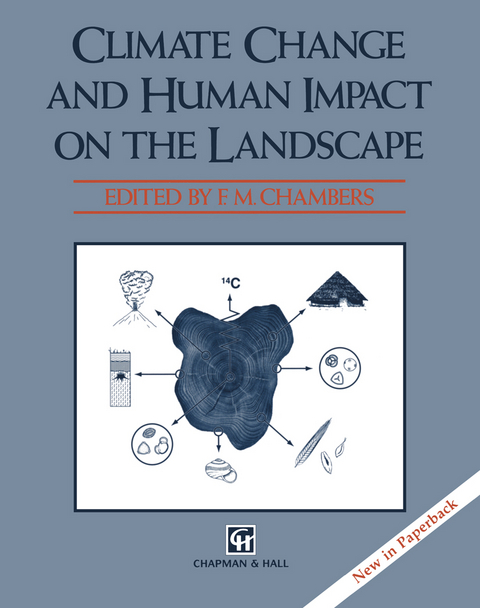
Climate Change and Human Impact on the Landscape
Chapman and Hall (Verlag)
978-0-412-61860-4 (ISBN)
I am pleased to present this volume of invited reviews and research case studies, produced to mark the retirement of Professor A. G. Smith - one of the leading researchers in Holocene palaeoecology. A. G. Smith took his first degree at the University of Sheffield, graduating in 1951 with a first-class honours degree in Botany. His doctorate was awarded in 1956 for a study in late-Quaternary vege tational history, based in the Sub-Department of Quaternary Research at the University of Cambridge, under the supervision of the late Sir Harry Godwin, FRS. He then researched and taught at Queen's University, Belfast, from 1954, leading the Nuffield Quaternary Research Unit there, becoming Co-Director of the Palaeoecology Laboratory from 1964. He was appointed Professor and Head of the Department of Botany (later, Plant Science) at University College, Cardiff, in 1973, and retired from the School of Pure and Applied Biology at the renamed University of Wales College, Cardiff, in August 1991. Although his principal interests have been concerned with the post-glacial environmental history of the British Isles, Professor Smith has significantly in fluenced many researchers elsewhere in their interpretation of biological and other evidence for human modification of the natural environment.
One: Precision and Accuracy in Studies of Climatic Change and Human Impact.- 1 Precision, concepts, controversies: Alan Smith’s contributions to vegetational history and palaeoecology.- 2 Forward to the past: changing approaches to Quaternary palaeoecology.- 3 Radiocarbon dating and the palynologist: a realistic approach to precision and accuracy.- 4 Great oaks from little acorns...: precision and accuracy in Irish dendrochronology.- Two: Climatic Change on the Landscape.- 5 Peat bogs as sources of proxy climatic data: past approaches and future research.- 6 Forest response to Holocene climatic change: equilibrium or non-equilibrium.- 7 Isolating the climatic factors in early- and mid-Holocene palaeobotanical records from Scotland.- 8 Radiocarbon dating of arctic-alpine palaeosols and the reconstruction of Holocene palaeoenvironmental change.- Three: Evidence for Human Impact.- 9 Earliest palynological records of human impact on the world’s vegetation.- 10 Vegetation change during the Mesolithic in the British Isles: some amplifications.- 11 The development of high moorland on Dartmoor: fire and the influence of Mesolithic activity on vegetation change.- 12 Models of mid-Holocene forest farming for north-west Europe.- 13 The influence of human communities on the English chalklands from the Mesolithic to the Iron Age: the molluscan evidence.- 14 Mesolithic, early Neolithic, and later prehistoric impacts on vegetation at a riverine site in Derbyshire, England.- 15 Holocene (Flandrian) vegetation change and human activity in the Carneddau area of upland mid-Wales.- 16 Early land use and vegetation history at Derryinver Hill, Renvyle Peninsula, Co. Galway, Ireland.- Four: Climatic Change and Human Impact: Relationship and Interaction.- 17 Rapid early-Holocene migrationand high abundance of hazel (Corylus avellana L.): alternative hypotheses.- 18 The origin of blanket mire, revisited.- 19 Climatic change and human impact during the late Holocene in northern Britain.- 20 Palaeoecology of floating bogs and landscape change in the Great Lakes drainage basin of North America.- 21 Late Quaternary climatic change and human impact: commentary and conclusions.- References.
| Erscheint lt. Verlag | 28.7.1994 |
|---|---|
| Zusatzinfo | 21 Illustrations, black and white; XXI, 303 p. 21 illus. |
| Verlagsort | London |
| Sprache | englisch |
| Maße | 203 x 254 mm |
| Themenwelt | Naturwissenschaften ► Biologie ► Ökologie / Naturschutz |
| Naturwissenschaften ► Geowissenschaften ► Meteorologie / Klimatologie | |
| Naturwissenschaften ► Geowissenschaften ► Mineralogie / Paläontologie | |
| Sozialwissenschaften | |
| ISBN-10 | 0-412-61860-5 / 0412618605 |
| ISBN-13 | 978-0-412-61860-4 / 9780412618604 |
| Zustand | Neuware |
| Haben Sie eine Frage zum Produkt? |
aus dem Bereich


